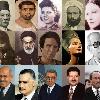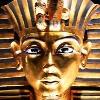

|DescriptionCollage of images representing Egyptian people. <br> Tags: Egyptians View |
Tags: Egyptians View |
Tags: Egyptians View |
|||||||||
Egyptians (Standard Arabic (Arabic language): langar ???????? langar-Latnmi?riy?n; Egyptian Arabic: langarz ??????? langarz-Latnma?reyy?n; Coptic (Coptic language): Coptic??????????? langcop-Latnhan.remenk?mi) is the name of the nationality and Mediterranean North African ethnic group Citation neededdate=June 2010 native to Egypt.
Egyptian identity is closely tied to the Geography of Egypt, dominated by the lower Nile Valley, the small strip of cultivable land stretching from the First Cataract (Cataracts of the Nile) to the Mediterranean and enclosed by desert both to the east (Eastern Desert) and to the west (Western Desert (North Africa)). This unique geography has been the basis of the development of Egyptian society since antiquity (Ancient Egypt).
The daily language of the Egyptians is the local variety of Arabic, known as Egyptian Arabic or Masri. Egyptians are predominantly adherents of Sunni Islam with a Shia minority and a significant proportion who follow native Sufi orders (tariqah). A sizable minority of Egyptians belong to the Coptic Orthodox Church, whose liturgical language, Coptic (Coptic language), is the last stage of the indigenous Egyptian language. The national identity of Egyptians as it developed in the 19th to 20th centuries consists of overlapping or conflicting ideologies, secular modern Egyptian nationalism (sometimes extending to ancient-Egypt nationalism, also known as "Pharaonism"), Arab nationalism (including pan-Arabism), and Islamism.
Group: Egyptians,??????? ''langarz-LatnMa?reyy?n'',Coptic??????'????? ''langcop-Latnhan.Remenk?mi''
Population: ca. 83 million (2008)
Region1: flagcountryEgypt
Pop1: ca. 81.3 million (2008 estimate)
Region2: flagcountrySaudi Arabia
Pop2: 900,000 (2004)
Ref2: lower
Region3: flagcountryLibya
Pop3: 333,000 (1999)
Ref3: lower
Region4: flagcountryUnited States
Pop4: 318,000 (2000)
Ref4: lower
Region5: flagcountryJordan
Pop5: 227,000 (1999)
Ref5: lower
Region6: flagcountryKuwait
Pop6: 191,000 (1999)
Ref6: lower
Region7: flagcountryUnited Kingdom
Pop7: 147,102 (2000)
Ref7: lower
Region8: flagcountryUAE
Pop8: 140,000 (2002)
Ref8: lower
Region9: flagcountryCanada
Pop9: 110,000 (2000)
Ref9: lower
Region10: flagcountryItaly
Pop10: 90,000 (2000)
Ref10: lower
Region11: flagcountryAustralia
Pop11: 65,280 (2006)
Ref11: lower
Region12: flagcountryIraq
Pop12: 66,000 (1999)
Ref12: lower
Region13: flagcountryGreece
Pop13: 60,000 (2000)
Ref13: lower
Region14: flagcountryGermany
Pop14: 40,000 (2000)
Ref14: lower
Region15: flagcountryNetherlands
Pop15: 40,000 (2000)
Ref15: lower
Region16: flagcountryFrance
Pop16: 36,000 (2000)
Ref16: lower
Region17: flagcountryAustria
Pop17: 14,000 (2000)
Ref17: lower
Region18: flagcountrySwitzerland
Pop18: 14,000 (2000)
Ref18: lower
Region19: flagcountrySpain
Pop19: 12,000 (2000)
Ref19: lower
Region20: flagcountryIsrael
Pop20: 11,000 (2005)
Ref20: lower
Langs: Egyptian Arabic (formerly also Coptic (Coptic language))
Rels: rels = Mainly: Islam, Coptic Orthodox Christianity (Coptic Orthodox Church of Alexandria)



